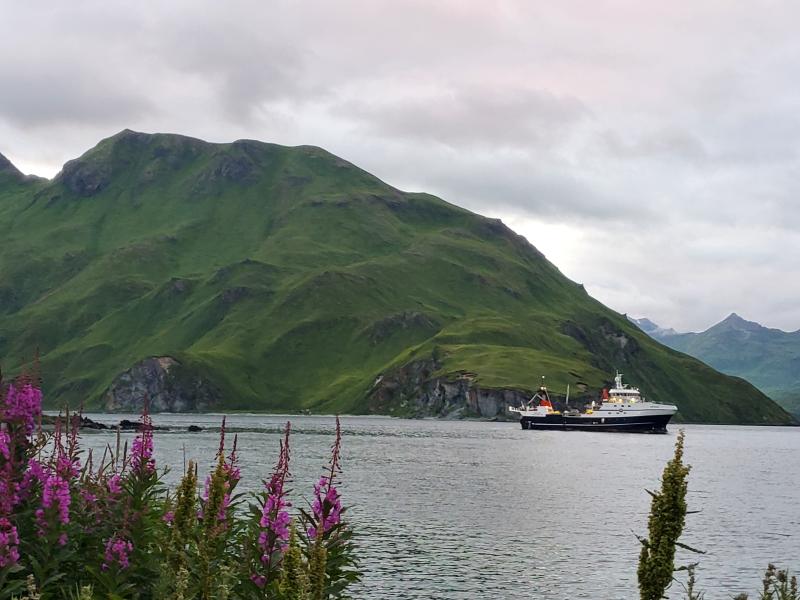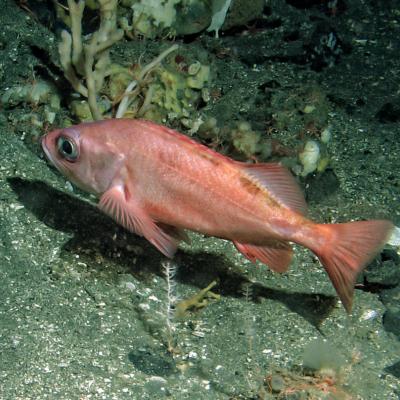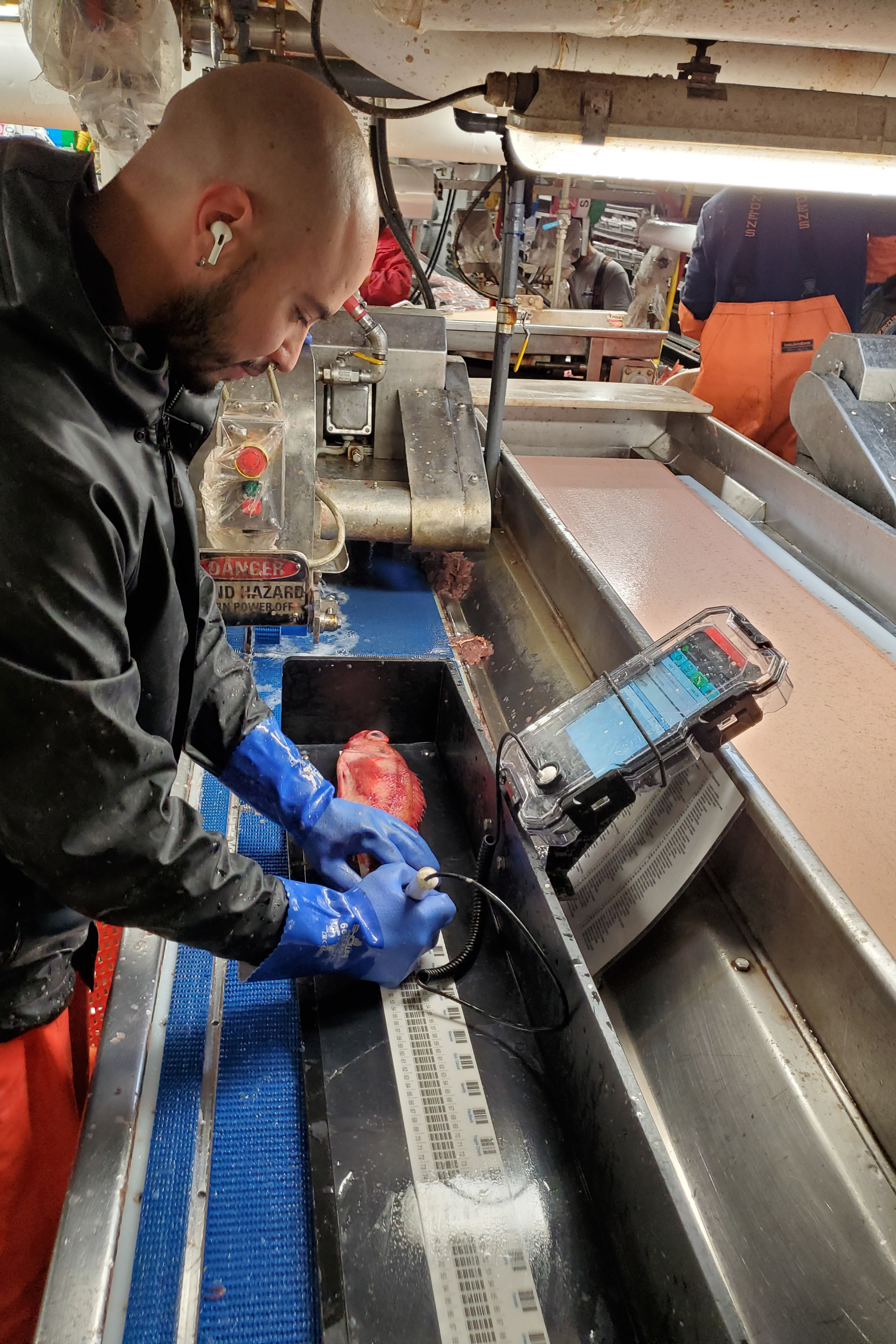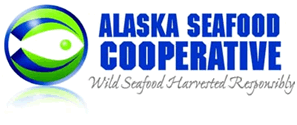Collaborative Rockfish Survey Yields Promising Results
NOAA NEWS, September 20, 2023 –
A government-industry survey is helping fill in the gaps on rockfish distribution and abundance in areas where standard government research gear can’t sample.

Fishing vessel, Araho, leaving port in Alaska to begin collaborative industry-government survey in Alaska. Credit: Rory Morgan
This is the third year of a successful pilot project in the Gulf of Alaska. NOAA Fisheries scientists, academic scientists at Alaska Pacific University’s FAST lab, and rockfish fishermen are working together to provide survey data in formerly inaccessible rocky areas of the Gulf. Called the Science/Industry Rockfish Research Collaboration in Alaska (SIRRCA), the team collected a variety of data on several species of rockfish. There is little data available for some of these species.
In the Gulf of Alaska, there are more than 30 species of rockfish. The focus of this study is on Pacific ocean perch, dusky rockfish, and northern rockfish.

Pacific ocean perch. Credit: NOAA Fisheries.
Based on previous NOAA Fisheries annual surveys, Pacific ocean perch numbers have increased in recent years. Dusky and northern rockfish numbers have been low. However, the habitats of all three of these species include rough, rocky areas, which are inaccessible to the NOAA Fisheries bottom trawl survey gear. This makes it difficult to get complete data on these populations. These hard-to-reach areas make up about 18 percent of the Gulf of Alaska seafloor. By working with fishermen, the science team was also able to collect needed biological information on fish condition (i.e., length, weight) for stock assessments.
Limited Data can Limit Fishing Opportunities
For dusky and northern rockfish, data from the bottom trawl survey is limited. This leads to greater uncertainty in the assessment models. When models are less precise, management measures require a much more conservative approach to prevent overfishing the fish stocks. If these stocks are healthy, this precautionary management may limit sustainable fishing opportunities.
“Sampling these rocky areas is necessary to improve our understanding of rockfish distribution and abundance and provide more accurate stock assessments so resource managers can set sustainable fishing quotas,” said Dr. Madison Hall, fisheries biologist, Alaska Fisheries Science Center who is leading the effort. “Our fishing industry partners involved in SIRRCA are fully invested in this effort to advance sustainable management for these long-lived, late maturing rockfish species. They recognize that collecting SIRRCA data and improving assessment models may ultimately increase or decrease fishing opportunities (via higher or lower fishing quotas) depending on model outcome. Better models means better management, and good management is important for sustaining both the fishery and the fish populations in the long-run. We are all on the same page about that.”
Survey Highlights
This year, the survey was conducted in June and July. The team completed 73 tows, spanning a large area in the western and central Gulf of Alaska. The research team worked with three partner vessels to conduct the cooperative survey: Amendment 80 vessels Seafisher, America’s Finest, and Araho.
“The partnership with the industry has been invaluable. Our industry partners have experience fishing in these areas. They possess the skills to safely navigate the rough terrain. This is important for unbiased data collection,” said Hall.
Commercial fishermen and their fishing cooperatives have been participating in this research for several years now. They understand this project is key to the long-term health of the rockfish populations on which they depend.
“Even if the fish we catch from the survey hauls doesn’t cover our costs for fuel and crew, conducting the survey under the scientific protocols is the right thing for industry to be doing,” said Captain Stan Morgan, F/V Araho.
Another project partner who has been involved since the project genesis is Captain Bob Hezel. Hezel is a seasoned fisherman, fishing in Alaska since the 1970s.
“The project has a lot of potential to help us unite what fishermen see on the water every day with what scientists see during their annual survey snapshots. It will fill in important gaps in the data for areas that the surveys are missing,” says Hezel. “The new information will help improve rockfish estimates and support more sustainable fisheries.”

David Rodriguez measures rockfish caught during a collaborative survey in Alaska. Photo credit: Rory Morgan
Ensuring Data Collected Can be Used in Stock Assessments
The process of developing a standardized survey took some time. First, scientists examined historical fishing industry data. They wanted to see if it could be used to calibrate rockfish catch data between industry boats and survey boats from the NOAA Fisheries bottom trawl survey. This is an important step for working industry data into blended abundance estimates.
Next, Hall and the team worked to adapt NOAA Fisheries bottom trawl survey methods to work on partnering industry vessels.
“We have to be consistent in the way we collect data. This helps ensure we can compare across areas and years. It also helps us detect trends in abundance—whether populations are going up or down,” said Hall.
Through data analysis and conversations with fishermen, scientists determined how best to assess abundance in these areas. When combined with data collected from other areas, scientists are able to get a better picture of the entire population for each of these species.
Data are being collected using different commercial fishing vessels than are contracted to conduct the annual NOAA Fisheries bottom trawl survey. So, scientists need to conduct “calibration tows.”
This year, the fishing vessels in the pilot program conducted 30 calibration tows in the same areas sampled during the annual NOAA Fisheries bottom trawl survey. They also conducted 43 experimental tows in rocky areas—areas where the standard NOAA Fisheries survey vessels can’t go. Scientists are using statistical methods to correct for any differences in catch rates between the different vessels.
“It’s important that we understand and correct for the differences in catch rates so that the data can be used to accurately estimate fish abundance in the area,” said Hall. “To do this right takes time. Vessel calibration experiments must be carefully planned and executed to produce useful and precise correction factors. This is essential to make sense of the experimental catches we see on our partnering industry vessels sampling in rocky areas.”
Scientists were able to collect important biological information from these tows. They collected:
- 51 biological samples from harlequin rockfish to be used in genetic studies
- Catch, length, and weights for Pacific ocean perch, northern rockfish and dusky rockfish
- Location information (latitude/longitude) for each of the hauls
- Acoustic information to complement biological data for estimating fish abundance
“I am quite pleased that our member companies and their vessels stepped up to fit the rockfish survey into their busy fishing seasons. They were able to cover all the locations that were selected for the survey, even if sometimes this meant steaming hours from where they normally fish. Most of all, it’s really rewarding to hear from our science partners that our captains and their crews were able to conduct the research hauls in a way that ensures the data will eventually be useful to improve rockfish stock assessments,” said John Gauvin, science projects director for the Alaska Seafood Cooperative. “We’re hopeful that this project will demonstrate the value of industry-science partnerships to augment this and other fisheries data collection efforts.”
What’s next for the rockfish project?
The team plans to hold a workshop in the fall to review how the survey went and develop a plan for the future of the project. There also is a substantial amount of data to analyze from this year’s hauls in both calibration and experimental tows. With 3 years of data, the next phase of the project will be working to integrate the data into the stock assessments.
“We need to collect enough data to make real improvements to the population estimates, but also we need to make sure our industry partners are not overburdened by the sampling methods. We know that going to these additional areas uses extra fuel and takes time away from commercial fishing and that the survey catches are too small to fully compensate for this. We have to find a level of sampling that works both for the survey and our industry partners,” said Hall.
Beyond that, the team hopes to expand the cooperative rockfish survey efforts to include other rockfish species/groups (e.g., harlequin) and regions (i.e., the Aleutians).
Special thanks to:
- John Gauvin, the Alaska Seafood Cooperative
- The Groundfish Forum
- The Alaska Groundfish Databank
- AIS Observers Inc.(Luke Syzmanski, Rory Morgan, David Rodriguez)
- Dr. Brad Harris from Alaska Pacific University
- Fishermen’s Finest (Captain Bob Hezel, Captain Erin Moore, Annika Saltman, the crew of the America’s Finest)
- Ocean Peace (Captain Pat Haley, Todd Loomis, the crew of the Seafisher)
- The O’Hara Corporation (Captain Stan Morgan, Jason Anderson, Frank Fogg, Mary Beth Tooley, the crew of the Araho)
